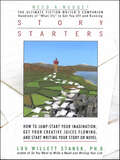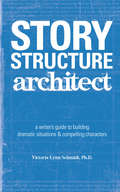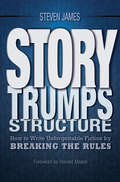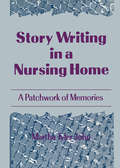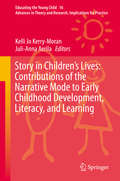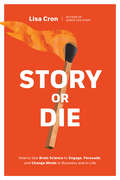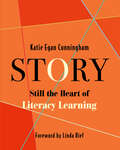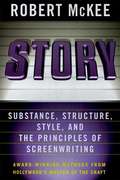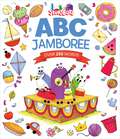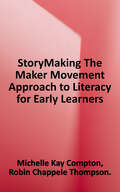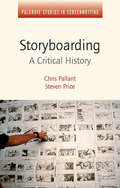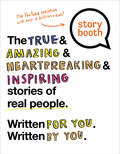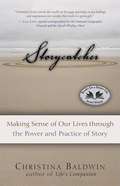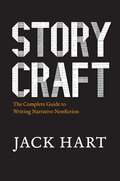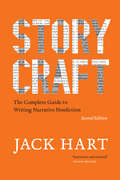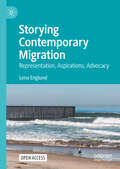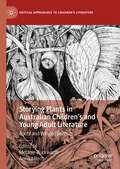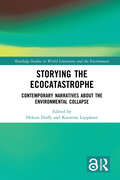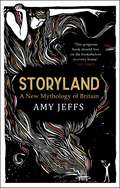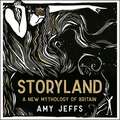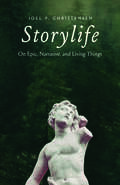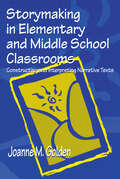- Table View
- List View
Story Starters: How to Jump-Start Your Imagination, Get Your Creative Juices Flowing, and Start Writing Your Story or Novel
by Lou Willett StanekIf you have the passion and energy to write fiction, but have trouble finding an idea and getting started, this is the perfect book for you. Lou Willett Stanek has helped scores of new authors in her acclaimed writing workshops—and now she shows you how to look and listen, how to find stories and begin shaping them like a writer.Here's how to find inspiration from neighbors and strangers, reshape classic tales, cull current events and use other tricks of the writing trade so effectively you'll soon find yourself brimming with ideas, your imagination revved to its full potential. Begin with a snippet of overheard conversation, an unexpected event, a simple character trait, a place, a problem—Ms. Stanek teaches you to get past "what really happened" and reinvent reality in ways that will astound and delight you, and hold a reader's attention.Here too are hundreds of "what-ifs," simple situations you can guide to endlessly different conclusions—and use to learn new ways to fashion plot, describe character, develop conflict, paint with language, create a setting, employ flashbacks, build suspense, and much, much more. For every writer who could use a jump-start, from novice to pro, here is a book that will help you keep the faith and. . .Thousands of stories are just waiting to be told—by you. Get started!
Story Structure Architect: A Writer's Guide to Building Dramatic Situations and Compelling Characters
by Victoria Lynn SchmidtBuild a Timeless, Original Story Using Hundreds of Classic Story Motifs! It's been said that there are no new ideas; but there are proven ideas that have worked again and again for all writers for hundreds of years. Story Structure Architectis your comprehensive reference to the classic recurring story structures used by every great author throughout the ages. You'll find master models for characters, plots, and complication motifs, along with guidelines for combining them to create unique short stories, novels, scripts, or plays. You'll also learn how to: Build compelling stories that don't get bogged down in the middle Select character journeys and create conflicts Devise subplots and plan dramatic situations Develop the supporting characters you need to make your story work Especially featured are the standard dramatic situations inspire by Georges Polti's well-known 19th century work,The Thirty-Six Dramatic Situations. But author Victoria Schmidt puts a 21st-century spin on these timeless classics and offers fifty-five situations to inspire your creativity and allow you even more writing freedom. Story Structure Architectwill give you the mold and then help you break it. This browsable and interactive book offers everything you need to craft a complete, original, and satisfying story sure to keep readers hooked!
Story Trumps Structure: How to Write Unforgettable Fiction by Breaking the Rules
by Steven JamesDon't limit your fiction - LIBERATE ITAll too often, following the "rules" of writing can constrict rather than inspire you. With Story Trumps Structure, you can shed those rules - about three-act structure, rising action, outlining, and more - to craft your most powerful, emotional, and gripping stories.Award-winning novelist Steven James explains how to trust the narrative process to make your story believable, compelling, and engaging, and debunks the common myths that hold writers back from creating their best work.Ditch your outline and learn to write organically.Set up promises for readers - and deliver on them.Discover how to craft a satisfying climax.Master the subtleties of characterization.Add mind-blowing twists to your fiction.When you focus on what lies at the heart of story - tension, desire, crisis, escalation, struggle, discovery - rather than plot templates and formulas, you'll begin to break out of the box and write fiction that resonates with your readers. Story Trumps Structure will transform the way you think about stories and the way you write them, forever.
Story Writing in a Nursing Home: A Patchwork of Memories
by Martha A JohnBased on the belief that older people have good stories to tell, Story Writing in a Nursing Home was developed as part of a volunteer teaching service to a nursing home. Graduate students who were learning to teach this special population conducted story writing activities with older adults and found that even the frail elderly who are confined to nursing centers provided a unique perspective about events that emphasize the lasting verities in life. The idea of a patchwork was derived from one of the lessons taught and was suggested by one of the older participants who said, “We’re sort of like a patchwork quilt.” The information, memories, and humor the elderly see in situations is worth recording. In addition, Story Writing in a Nursing Home emphasizes the way to develop the mental stimulation that is so important for physical well being. This sensitive and insightful book provides a lesson plan outline and the type of content that was used as an example. It also provides a running commentary in the form of a diary that tells how to begin a teaching program for nursing center residents. Students and professionals interested in implementing a similar program can use these ideas for planning and for organizing the use of student help to better serve the population. Fascinating reading, this book includes stories by frail elderly people, lesson plans, tips on working with administrators in a nursing center, and reasons for providing instruction. Teachers, volunteers, librarians, gerontology/sociology students, and others concerned with the well-being of the elderly will refer often to this instructive volume.
Story in Children's Lives: Contributions of the Narrative Mode to Early Childhood Development, Literacy, and Learning (Educating the Young Child #16)
by Kelli Jo Kerry-Moran Juli-Anna AerilaThis book is based on the power of stories to support children in all areas of their lives. It examines the role narratives can play in encouraging growth in contexts and domains such as personal and family identity, creative movement, memory and self-concept, social relationships, or developing a sense of humor. Each chapter describes innovative and research-based applications of narratives such as movement stories, visual narratives to develop historical thinking, multimodal storytelling, bibliotherapy, mathematics stories, family stories, and social narratives. The chapters elaborate on the strength of narratives in supporting the whole child in diverse contexts from young children on the autism spectrum improving their social skills at school, to four- and five-year-olds developing historical thinking, to children who are refugees or asylum-seekers dealing with uncertainty and loss. Written by accomplished teachers, researchers, specialists, teaching artists and teacher educators from several countries and backgrounds, the book fills a gap in the literature on narratives. “…this work delves into the topic of narratives in young children’s lives with a breadth of topics and depth of study not found elsewhere.” “Collectively, the insights of the contributors build a convincing case for emphasizing story across the various disciplines and developmental domains of the early childhood years.” “The writing style is scholarly, yet accessible. Authors used a wide array of visual material to make their points clearer and show the reader what meaningful uses of story “look like”.” Mary Renck Jalongo, Journal and Book Series Editor Springer Indiana, PA, USA
Story or Die: How to Use Brain Science to Engage, Persuade, and Change Minds in Business and in Life
by Lisa Cron&“A practical, heartfelt manual for anyone who needs to change minds and actions. Lisa Cron shares the art of practical empathy with leaders who care enough to make a difference.&”—Seth Godin, author of The Practice A step-by-step guide to using the brain&’s hardwired need for story to achieve any goal, from the author of Wired for Story Whether you&’re pitching a product, saving the planet, or convincing your kids not to text and drive, story isn&’t just one way to persuade. It&’s the way. It&’s built into the architecture of the brain, and has been since early humans gathered around the camp fire, trying to figure out how to outsmart the lion next door.In Story or Die, story coach Lisa Cron sets out to decode the power of story, first by examining how the brain processes information, translates it into narrative, and then guards it as if your life depends on it. Armed with that insight, she focuses on how to find your real target audience and then pinpoint their hidden resistance. Finally, she takes you, step-by-step, through the creation of your own story, one that allows your audience to overcome their resistance and take up your call to action, not because you told them to, but because they want to.That is the power of story. Use it wisely.
Story: Still the Heart of Literacy Learning
by Katie CunninghamStories are all around us. From our digital newsfeeds, interactions with one another, to watching a movie or listening to a curated playlist, we see and hear different tales told to us in various ways.In her book, Story: Still the Heart of Literacy Learning, author and teacher Katie Egan Cunningham reminds us that when we bridge reading strategies with the power of story, we can deepen literacy learning and foster authentic engagement with students. Cunningham shows how to create classrooms of caring and inquisitive readers, writers, and storytellers. Inside you'll find: How to build a diverse, multicultural classroom library that reflects all voices through rich, purposeful, and varied textsNumerous examples of multi-genre and multi-modal stories from children's and young adult literatureA practical toolkit at the end of each chapter to demonstrate how to make stories come alive in any classroom Throughout the book, Cunningham shares her experiences as a teacher, literacy specialist, and staff developer and how building and talking about stories brings them to life. She honors the importance of teaching strategies to read different kinds of text, to write across genres, and to speak and listen with purpose while reminding us about the importance of story.
Story: Style, Structure, Substance, and the Principles of Screenwriting
by Robert MckeeRobert McKee's screenwriting workshops have earned him an international reputation for inspiring novices, refining works in progress and putting major screenwriting careers back on track. Quincy Jones, Diane Keaton, Gloria Steinem, Julia Roberts, John Cleese and David Bowie are just a few of his celebrity alumni. Writers, producers, development executives and agents all flock to his lecture series, praising it as a mesmerizing and intense learning experience. In Story, McKee expands on the concepts he teaches in his $450 seminars (considered a must by industry insiders), providing readers with the most comprehensive, integrated explanation of the craft of writing for the screen. No one better understands how all the elements of a screenplay fit together, and no one is better qualified to explain the "magic" of story construction and the relationship between structure and character than Robert McKee.
StoryBots ABC Jamboree (StoryBots)
by StorybotsIt's an alphabet extravaganza starring the curious crew from the award-winning StoryBots apps, videos, and Emmy Award winning Netflix show!ABC Jamboree is packed with rollicking rhyming text and items from A to Z, brought to you by the StoryBots. Whether they are bouncing on a bed or eating cupcakes at a circus, the StoryBots have fun wherever they go and whatever they do, helping little learners master the alphabet in a most entertaining way. A special "seek and find" page at the end invites readers to go back through the book to find a special object for each letter. For the child who loves Richard Scarry's books, for fans of the Netflix show Ask the StoryBots, and for any child learning the alphabet, this book is a perfect addition to a home library!
StoryMaking: The Maker Movement Approach to Literacy for Early Learners
by Robin Chappele Thompson Michelle Kay ComptonAfter studying the current research on literacy learning for young children, delving into the beliefs and schools of Reggio Emilia, and discovering the Maker Movement, the authors created StoryMaking. With great success, they implemented it in their diverse and large public school district. StoryMaking shares the processes, first steps, next steps, use for materials, and lessons learned so teachers can implement their versions in their classrooms. The book shares practical suggestions, student samples, photographs, anchor charts, and other forms of documentation.
Storyboarding: A Critical History (Palgrave Studies in Screenwriting)
by Steven Price Chris PallantThis study provides the first book-length critical history of storyboarding, from the birth of cinema to the present day and beyond. It discusses the role of storyboarding in key films including Gone with the Wind , Psycho and The Empire Strikes Back , and is illustrated with a wide range of images.
Storybooth
by Storybooth“Compelling . . . important . . . Be sure to leave this out where kids can find it.” –Booklist “Their powerful stories, along with the compelling animation, help build empathy and respect for differences—key components in the fight against hate.” -Deborah Lauter, Executive Director, NYC Office for the Prevention of Hate Crimes, 2019-22. “Storybooth reminds us that authentic, youth-curated, real world narratives are incredibly resonant and can move our nation to act! “ - Michael H Levine, PhD, SVP, NickelodeonFrom Storybooth—the YouTube storytelling sensation with over five million subscribers—comes a full-color, illustrated compilation of never-before-seen and classic stories that combine the compelling storytelling of Humans of New York, the affirming tone of Chicken Soup for the Teenage Soul, and the “you can” attitude of The Confidence Code for Girls. Everyone has a story.These are ours.Each one of these tales connects you to someone you never knew. A real person, sharing their lived experience. Exciting, inspirational, heartwrenching, uplifting, humorous, devastating, thought-provoking—TRUE.Storybooth illustrates for readers that no matter what is happening in their world, they are not alone.Real stories submitted by real people, Storybooth allows each contributor to speak for themselves about their experiences, imparting a myriad of raw, achingly honest, and deeply soulful truths with the power to touch each and every individual reader.
Storycatcher: Making Sense of Our Lives Through the Power and Practice of Story
by Christina BaldwinStory is the heart of language. Story emotionally moves us to love and hate and can motivate us to change the whole course of our lives. Story can lift us beyond the borders of our individuality to imagine realities of other people, times, and places; to empathize with other beings; to extend our supposing far into the universe. Storytelling - both oral tradition and written word - is the foundation of being human. In her powerful new book, Christina Baldwin, one of the visionaries who started the personal writing movement, explores the vital necessity of re-creating a sacred common ground for each other's stories. Each chapter in Storycatcher is carried by a fascinating tale - about people, family, or community - intertwined with practical instruction about the nature of story, how it works and how we can practise it in our lives. The art of storycatching invites us to spend time speaking and listening, writing and reading, reclaiming the meaning missing from our lives. This book passionately calls for humanity to hang on to its voice, its love of reading and writing, and its understanding that story is our soul. Whether exploring the personal stories revealed in our private journals, the stories of family legacy, the underlying stories that drive our organizations, or the stories that define our broadest definitions of identity, Christina encourages us all to become storycatchers - people who value story and find ways in the midst of everyday life to practise storytelling. Baldwin shows us how new stories lay the framework for a new world.
Storycraft
by Jack HartFrom the work of the New Journalists in the 1960s, to the New Yorker essays of John McPhee, Susan Orlean, Atul Gawande, and a host of others, to blockbuster book-length narratives such as Mary Roach’s Stiff or Erik Larson’s Devil in the White City, narrative nonfiction has come into its own. Yet writers looking for guidance on reporting and writing true stories have had few places to turn for advice. Now in Storycraft, Jack Hart, a former managing editor of the Oregonian who guided several Pulitzer Prize–winning narratives to publication, delivers what will certainly become the definitive guide to the methods and mechanics of crafting narrative nonfiction. Hart covers what writers in this genre need to know, from understanding story theory and structure, to mastering point of view and such basic elements as scene, action, and character, to drafting, revising, and editing work for publication. Revealing the stories behind the stories, Hart brings readers into the process of developing nonfiction narratives by sharing tips, anecdotes, and recommendations he forged during his decades-long career in journalism. From there, he expands the discussion to other well-known writers to show the broad range of texts, styles, genres, and media to which his advice applies. With examples that draw from magazine essays, book-length nonfiction narratives, documentaries, and radio programs, Storycraft will be an indispensable resource for years to come.
Storycraft, Second Edition: The Complete Guide to Writing Narrative Nonfiction (Chicago Guides to Writing, Editing, and Publishing)
by Jack HartJack Hart, master writing coach and former managing editor of the Oregonian, has guided several Pulitzer Prize–winning narratives to publication. Since its publication in 2011, his book Storycraft has become the definitive guide to crafting narrative nonfiction. This is the book to read to learn the art of storytelling as embodied in the work of writers such as David Grann, Mary Roach, Tracy Kidder, and John McPhee. In this new edition, Hart has expanded the book’s range to delve into podcasting and has incorporated new insights from recent research into storytelling and the brain. He has also added dozens of new examples that illustrate effective narrative nonfiction. This edition of Storycraft is also paired with Wordcraft, a new incarnation of Hart’s earlier book A Writer’s Coach, now also available from Chicago.
Storycraft, Second Edition: The Complete Guide to Writing Narrative Nonfiction (Chicago Guides to Writing, Editing, and Publishing)
by Jack HartJack Hart, master writing coach and former managing editor of the Oregonian, has guided several Pulitzer Prize–winning narratives to publication. Since its publication in 2011, his book Storycraft has become the definitive guide to crafting narrative nonfiction. This is the book to read to learn the art of storytelling as embodied in the work of writers such as David Grann, Mary Roach, Tracy Kidder, and John McPhee. In this new edition, Hart has expanded the book’s range to delve into podcasting and has incorporated new insights from recent research into storytelling and the brain. He has also added dozens of new examples that illustrate effective narrative nonfiction. This edition of Storycraft is also paired with Wordcraft, a new incarnation of Hart’s earlier book A Writer’s Coach, now also available from Chicago.
Storying Contemporary Migration: Representation, Aspirations, Advocacy
by Lena EnglundThis book examines contemporary stories of migration belonging to multiple literary genres such as nonfiction, memoir, novel, and essay, and explores the futures they envision for migrants and their surrounding societies. The primary material ranges from personal experiences of migration for professional purposes and of being undocumented without access to citizenship, to novels that provide fictional representations of migrants and their complex lives. This study asks how migration, as portrayed in contemporary writing, addresses personal, social, and political consequences of being on the move. The book is organised around central themes such as the status of being undocumented, or aspirations and expectations of both migrants themselves as well as their new environs. The material examined has been published from 2016 onwards, addressing the aftermath of the migrant crisis 2015-2016 as well as the Trump administration 2017-2021.
Storying Plants in Australian Children’s and Young Adult Literature: Roots and Winged Seeds (Critical Approaches to Children's Literature)
by Melanie Duckworth Annika HerbStorying Plants in Australian Children’s and Young Adult Literature: Roots and Winged Seeds explores cultural and historical aspects of the representation of plants in Australian children’s and young adult literature, encompassing colonial, postcolonial, and Indigenous perspectives. While plants tend to be backgrounded as of less narrative interest than animals and humans, this book, in conversation with the field of critical plant studies, approaches them as living beings worthy of attention. Australia is home to over 20,000 species of native plants – from pungent Eucalypts to twisting mangroves, from tiny orchids to spiky, silvery spinifex. Indigenous Australians have lived with, relied upon, and cultivated these plants for many thousands of years. When European explorers and colonists first invaded Australia, unfamiliar species of plants captured their imagination. Vulnerable to bushfires, climate change, and introduced species, plants continue to occupy fraught but vital places in Australian ecologies, texts, and cultures. Discussing writers from Ambelin Kwaymullina and Aunty Joy Murphy to May Gibbs and Ethel Turner, and embracing transnational perspectives from Ukraine, Poland, and Aotearoa New Zealand, Storying Plants addresses the stories told about plants but also the stories that plants themselves tell, engaging with the wide-ranging significance of plants in Australian children’s and Young Adult literature.
Storying the Ecocatastrophe: Contemporary Narratives about the Environmental Collapse (Routledge Studies in World Literatures and the Environment)
by Helena Duffy Katarina LeppänenHow do writers and artists represent the climate catastrophe so that their works stir audiences to political action or at least raise their environmental awareness without, however, appearing didactic? Storying the Ecocatastrophe attempts to answer this question while interrogating the potential of narrative to become a viable political force. The collection of essays achieves this by examining the representational strategies and ideological goals of contemporary cultural productions about climate change. These productions have been created across different genres, such as the traditional novel, dance performance, solarpunk, economic report, collage, and space opera, as well as across different languages and cultures. The volume’s twelve chapters demonstrate that rising temperatures, erratic weather, extinction of species, depletion of resources, and coastal erosion and flooding are an effect of our abusive relationship with nature. They also show that our use of nuclear power, extraction of natural resources and extensive farming, including heavy reliance on pesticides, intersect with intrahuman violence, as fleshed out by heteropatriarchy, racism, (neo)colonialism, and capitalism. They finally argue that human activity has indirectly contributed to other contemporary crises, namely the migrant crisis and the spread of contagious diseases such as Covid-19.Chapter 8 of this book is freely available as a downloadable Open Access PDF at http://www.taylorfrancis.com under a Creative Commons Attribution-Non Commercial-No Derivatives (CC BY-NC-ND) 4.0 license.
Storyland: A New Mythology of Britain
by Amy JeffsSoaked in mist and old magic, Storyland is a new illustrated mythology of Britain, set in its wildest landscapes.It begins between the Creation and Noah's Flood, follows the footsteps of the earliest generation of giants from an age when the children of Cain and the progeny of fallen angels walked the earth, to the founding of Britain, England, Wales and Scotland, the birth of Christ, the wars between Britons, Saxons and Vikings, and closes with the arrival of the Normans.These are retellings of medieval tales of legend, landscape and the yearning to belong, inhabited with characters now half-remembered: Brutus, Albina, Scota, Arthur and Bladud among them. Told with narrative flair, embellished in stunning artworks and glossed with a rich and erudite commentary. We visit beautiful, sacred places that include prehistoric monuments like Stonehenge and Wayland's Smithy, spanning the length of Britain from the archipelago of Orkney to as far south as Cornwall; mountains and lakes such as Snowdon and Loch Etive and rivers including the Ness, the Soar and the story-silted Thames in a vivid, beautiful tale of our land steeped in myth. It Illuminates a collective memory that still informs the identity and political ambition of these places.In Storyland, Jeffs reimagines these myths of homeland, exile and migration, kinship, loyalty, betrayal, love and loss in a landscape brimming with wonder.
Storyland: A New Mythology of Britain
by Amy JeffsA TIMES HISTORICAL FICTION BOOK OF THE YEAR SHORTLISTED FOR WATERSTONES BOOK OF THE YEAR Soaked in mist and old magic, Storyland is a new illustrated mythology of Britain, set in its wildest landscapes.It begins between the Creation and Noah's Flood, follows the footsteps of the earliest generation of giants from an age when the children of Cain and the progeny of fallen angels walked the earth, to the founding of Britain, England, Wales and Scotland, the birth of Christ, the wars between Britons, Saxons and Vikings, and closes with the arrival of the Normans.These are retellings of medieval tales of legend, landscape and the yearning to belong, inhabited with characters now half-remembered: Brutus, Albina, Scota, Arthur and Bladud among them. Told with narrative flair, embellished in stunning artworks and glossed with a rich and erudite commentary. We visit beautiful, sacred places that include prehistoric monuments like Stonehenge and Wayland's Smithy, spanning the length of Britain from the archipelago of Orkney to as far south as Cornwall; mountains and lakes such as Snowdon and Loch Etive and rivers including the Ness, the Soar and the story-silted Thames in a vivid, beautiful tale of our land steeped in myth. It Illuminates a collective memory that still informs the identity and political ambition of these places.In Storyland, Jeffs reimagines these myths of homeland, exile and migration, kinship, loyalty, betrayal, love and loss in a landscape brimming with wonder.
Storyland: A New Mythology of Britain
by Amy JeffsSoaked in mist and old magic, Storyland tells a history of Britain and the politics of its people through medieval eyes. Grounded in research, related as fiction, it begins before the Great Flood, with a troop of African giants quarrying stones. Later, the first migrants enter the Atlantic, calling themselves the Scoti and Britons, followed by the English and the Normans, crossing the North Sea. Storyland is ancient Britain as you have never seen it before, mediated by the modern aesthetic of its linocut illustrations. It is filled with places we know today and characters half-remembered: Lear in Leicester, Merlin in Stonehenge, Grim in Grimsby, St Columba on the River Ness. Storyland is a tale of legend, landscape and the yearning to belong.(P)2021 Quercus Editions Limited
Storylife: On Epic, Narrative, and Living Things
by Joel P. ChristensenFrom Homer’s epics to mainstream news, stories have lives of their own—and humans may not always control the narratives we create Combining ancient epic and myth with analogies from biology and the natural world, Joel P. Christensen explores the creative process and how narratives develop. This bold work urges readers to treat narratives as living things with their own agency in the world. Christensen starts by using Homeric epic to explore the way language and meaning develop alongside audiences in complex ecosystems and then moves through storytelling in the ancient Mediterranean over a thousand years. In this study, which ranges from the evolution of narratives to viral ideas, and to the dangerous side of stories in mass shootings and war, we see how narratives function as independent entities with consequences that cause lasting harm. Connecting his argument to the present day, Christensen addresses contemporary cultural panics, including AI and ChatGPT, “post-truth” or alt-facts in the digital age, and free speech and cancel culture. Storylife invites readers to rethink human creativity, the importance of collective actions, and the lives we build together with and against narrative. In an age rife with misinformation, it is time to reconsider how much control we have over stories and how to educate ourselves once we acknowledge the power that narrative exerts over us.
Storylistening: Narrative Evidence and Public Reasoning
by Claire Craig Sarah DillonStorylistening makes the case for the urgent need to take stories seriously in order to improve public reasoning. Dillon and Craig provide a theory and practice for gathering narrative evidence that will complement and strengthen, not distort, other forms of evidence, including that from science. Focusing on the cognitive and the collective, Dillon and Craig show how stories offer alternative points of view, create and cohere collective identities, function as narrative models, and play a crucial role in anticipation. They explore these four functions in areas of public reasoning where decisions are strongly influenced by contentious knowledge and powerful imaginings: climate change, artificial intelligence, the economy, and nuclear weapons and power. Vivid performative readings of stories from The Ballad of Tam-Lin to The Terminator demonstrate the insights that storylistening can bring and the ways it might be practised. The book provokes a reimagining of what a public humanities might look like, and shows how the structures and practices of public reasoning can evolve to better incorporate narrative evidence. Storylistening aims to create the conditions in which the important task of listening to stories is possible, expected, and becomes endemic. Taking the reader through complex ideas from different disciplines in ways that do not require any prior knowledge, this book is an essential read for policymakers, political scientists, students of literary studies, and anyone interested in the public humanities and the value, importance, and operation of narratives.
Storymaking in Elementary and Middle School Classrooms: Constructing and Interpreting Narrative Texts
by Joanne M. GoldenThis book examines storymaking processes in K-8 classrooms from a social-semiotic perspective that highlights how participants' discourse influences story construction and interpretation. It is unique in that it invites the reader to actively engage in the analysis of classroom discourse and to consider issues related to storymaking in specific classrooms. Examples of theory in action illustrate important issues regarding text selection and the roles of teachers and students in affecting meaning-making processes. An excellent text for upper-level and graduate courses in language, literacy, and literature education, Storymaking in Elementary and Middle School Classrooms includes: * Transcripts of teacher-student-text discourse in kindergarten, and second-, fifth-, seventh-, and eighth-grade classrooms. * Helpful overviews at the beginning of each chapter. * Theory-into-practice sections at the end of each chapter that pose issues to think about related to classroom practice. * A separate chapter on translating theory into practice in the classroom, with practical suggestions.
